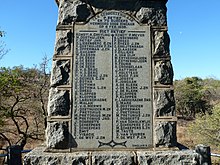Piet Retief Delegation massacre
| Piet Retief Delegation massacre | |
|---|---|
| Part of the Great Trek | |
 Monument to the massacre on 'Moordkoppie' (Murder Hill). | |
| Location | Hloma mabuto, uMgungundlovu, KwaZulu-Natal, |
| Date | 6 February 1838 |
| Deaths | 100 |
| Injured | Unknown |
| Perpetrators | Impi's of Dingane Zulu |
The Piet Retief Delegation massacre occurred when Voortrekkers under Piet Retief migrated into Natal in 1837 and negotiated a land treaty in February 1838 with the Zulu King Dingane. Upon reconsideration, Dingane doublecrossed the Voortrekkers, killing the delegation of 100 including their leader Piet Retief on 6 February 1838. The land treaty was later found in Piet Retief's possession. It gave the Voortrekkers the land between the Tugela River and Port St. Johns. This event eventually led to the Battle of Blood River and the eventual defeat of Dingane.
Massacre
Despite warnings, Retief left the Tugela region on 28 January 1838, in the belief that he could negotiate with Dingane for permanent boundaries for the Natal settlement. The deed of cession of the Tugela-Umzimvubu region, although dated 4 February 1838, was signed by Dingane on 6 February 1838, with the two sides recording three witnesses each. Dingane invited Retief's party to witness a special performance by his soldiers, whereupon Dingane ordered his soldiers to capture Retief's party and their coloured servants.
Retief, his son, men, and servants, about 100 people in total, were taken to a nearby ridge, Hlomo amabuto, which means "mustering of the soldiers".[1] The Zulus killed the entire party by clubbing them and killed Retief last, so as to witness the deaths of his comrades. Their bodies were left on the KwaMatiwane hillside to be eaten by vultures and scavengers,[2] as was Dingane's custom with his enemies.
Aftermath
After the Retief Party's death, Dingane directed the attack against the Voortrekker laagers of Bloukrans,[3] which plunged the Great Trek into temporary disarray and in total 534 men, women and children were killed in what became known as the Weenen massacre.
Piet Retief's death and the Weenen massacre eventually led to the decisive Voortrekker victory at Blood River, after which Andries Pretorius and his "victory commando" recovered the remains of the Retief party. They buried them on 21 December 1838.
Also recovered was the undamaged deed of cession from Retief's leather purse, written by Jan Gerritze Bantjes, Retief's secretary, as later verified by a member of the "victory commando", E.F. Potgieter. Two exact copies survive, (either of which could be the original) but legend states the original deed disappeared in transit to the Netherlands during the Anglo-Boer War. The site of the Retief grave was more or less forgotten until pointed out in 1896 by J.H. Hattingh, a surviving member of Pretorius's commando. A monument recording the names of the members of Retief's delegation was erected near the grave in 1922.[4]
See also
Notes
- ^ Wood, William (1840). "An Eyewitness Account of the Massacre of Retief". Statements respecting Dingaan, king of the Zulus. Collard & Co. Retrieved 2008-01-04.
- ^ Kotzé, D. J. (1950). Letters of the American Missionaries, 1835–1838. Cape Town: Van Riebeeck Society. p. 235.
- ^ Wood, William (1840). "An Eyewitness Account of the Massacre of Retief". Statements respecting Dingaan, king of the Zulus. Collard & Co. Retrieved 2008-01-04.
- ^ Stander, Eerw. P.P. Dingaanstat: Die Graf van Piet Retief en Sy Sewentig Burgers.
